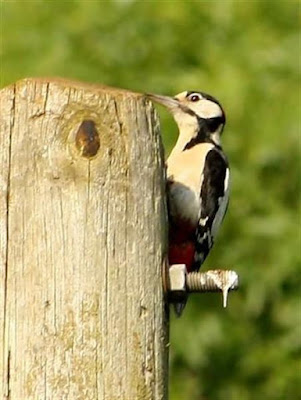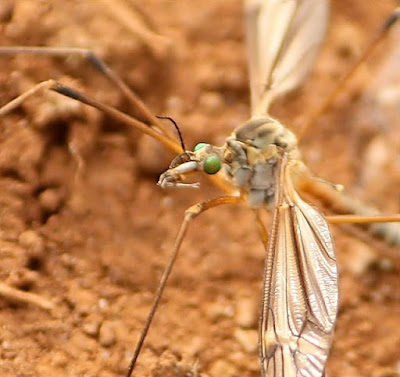
For various reasons, I haven't had many Nature outings in the last week or so, the weather certainly hasn't helped. When I said, on my last post, that we desperately needed rain I was rewarded the very next day but it doesn't know when enough is enough and I don't think we have had one day without it since. April finally arrived... in June! April of course, having masqueraded as June! I still can't believe how quickly the year is progressing, one minute it was the beginning of Spring and on June 24th it is midsummer's day!... It goes too fast...
'The days are clear,
Day after day,
When April's here,
That leads to May,
And June
Must follow soon:
Stay, June, stay! -
If only we could stop the moon
And June!'
When April's here,
That leads to May,
And June
Must follow soon:
Stay, June, stay! -
If only we could stop the moon
And June!'
(Christina Georgina Rossetti)
 Great Spotted Woodpecker
Great Spotted Woodpecker

I also saw this Bullfinch. Unfortunately the light was bad but I have included it as it is not often I manage to get a photo of one. I have seen Bullfinches several times in that location so hopefully, I may get a better photo eventually.
Not a very sharp photo of this member of the Crane-fly family but I had to put it in, just look at those eyes!!
Butterflies are in worryingly short supply in my area at the moment but thankfully the same can't be said of bees. I think both this one and the one at the beginning of my post are Bombus hortorum but from memory the collar and 2nd abdominal segment were quite a deep colour so wonder if they could be Bombus terrestris.
Edit: Thank you very much to Greenie for pointing out that the bee at the start of this post is probably not Bombus hortorum but a member of the Cuckoo Bee family possibly Psithyrus vestalis.
I haven't seen the Great Spotted Woodpecker in the garden since I last mentioned it (I may just have missed it of course) but I was pleased to see this one while on a local walk.
 Great Spotted Woodpecker
Great Spotted WoodpeckerHere, helpfully displaying the red on the back of his neck to show me he is male.

I also saw this Bullfinch. Unfortunately the light was bad but I have included it as it is not often I manage to get a photo of one. I have seen Bullfinches several times in that location so hopefully, I may get a better photo eventually.
Not a very sharp photo of this member of the Crane-fly family but I had to put it in, just look at those eyes!!
Butterflies are in worryingly short supply in my area at the moment but thankfully the same can't be said of bees. I think both this one and the one at the beginning of my post are Bombus hortorum but from memory the collar and 2nd abdominal segment were quite a deep colour so wonder if they could be Bombus terrestris.
Edit: Thank you very much to Greenie for pointing out that the bee at the start of this post is probably not Bombus hortorum but a member of the Cuckoo Bee family possibly Psithyrus vestalis.
'Across the open common land
shines glowing purple floral blooms
The bumble bee can hardly stand,
as flowers' scent is rising fumes'
shines glowing purple floral blooms
The bumble bee can hardly stand,
as flowers' scent is rising fumes'
(Stephen Patrick)
The Chiffchaff was in its usual place again :)
I'm not sure what this cheeky looking Squirrel was eating but it was certainly enjoying it.
Chaffinches always seem to be pretty accommodating when it comes to having their photo taken.
I had to heavily crop this very distant shot of a Common Buzzard so it is not the best but I have included it as I usually only see them in the air.
I took the next three photos some weeks ago but didn't get round to posting them.
 Mute Swan
Mute Swan
 Greylag Goose (hybrid)
Greylag Goose (hybrid)
Edit: Thanks to Greenie for pointing out the above is of mixed parentage. I should have noticed!!
 Coots
Coots
~~~
The above poem refers to the fact that Jackdaws are famous for using church steeples for nesting. They have a linear hierarchical group structure with higher ranked birds dominating lower ranked birds. They mate for life, pairing before sexual maturity. Young males establish individual status before pairing with females. Once paired, the female assumes the same social position as her partner. Un-mated females are the lowest members in the pecking order, and are the last to have access to food and shelter. Hmm, I think they need a bit of women's liberation in their community :)
It is known that Jackdaws share food and objects. The active giving of food in birds is found mainly in the context of parental care and during courtship rituals but Jackdaws show much higher levels of active giving than that documented for primates such as Chimpanzees. This behaviour is not fully understood but there is a theory that it is associated with mutualism, reciprocity and harassment avoidance. It is also known that occasionally the flock will make 'mercy killings' during which a sick or injured bird is mobbed until it is killed, a harsh but effective way of putting a suffering bird out of its misery...
~~~
This Robin started to build a nest in the Ivy at the side of the dining room window but for some reason I think it abandoned it before it was finished. There was one in there complete with baby birds a few years ago which was destroyed by a cat which unfortunately still visits the garden so in some ways I was pleased the Robin had second thoughts this year. I think it did nest in a different part of the garden though.
Until next time... enjoy the beauty of Nature, wherever you are.
The Chiffchaff was in its usual place again :)
I'm not sure what this cheeky looking Squirrel was eating but it was certainly enjoying it.
Grey Squirrel
'Intelligent his mien ;
With feathery tail and ears alert,
And little paws as hands expert,
And eyes so black and keen.'
And little paws as hands expert,
And eyes so black and keen.'
(Catherine Ann Turner Dorset (?))
Chaffinches always seem to be pretty accommodating when it comes to having their photo taken.
'The little bird sits at his door in the sun,
Atilt like a blossom among the leaves,
And lets his illumined body being o'errun
With the deluge of summer it receives'
Atilt like a blossom among the leaves,
And lets his illumined body being o'errun
With the deluge of summer it receives'
(James Russell Lowell)
I had to heavily crop this very distant shot of a Common Buzzard so it is not the best but I have included it as I usually only see them in the air.
I took the next three photos some weeks ago but didn't get round to posting them.
 Mute Swan
Mute Swan Greylag Goose (hybrid)
Greylag Goose (hybrid)Edit: Thanks to Greenie for pointing out the above is of mixed parentage. I should have noticed!!
 Coots
Coots~~~
The following two photos were taken in the garden. I hadn't seen a Jackdaw visit for some time until this year, when I have seen several. In my opinion the Jackdaw is a very smart bird in both senses of the word. Not only does it look handsome but like the rest of the much maligned and highly intelligent Corvid family it is a very interesting bird. Jackdaws usually nest in colonies with monogamous pairs collaborating to locate a nest site which they then defend from other pairs and from predators for most of the year. They nest in the cavities of trees, cliffs or ruined, and sometimes inhabited, buildings, often in chimneys (sometimes with fatal consequences when a fire is in the grate below!), and even in dense conifers.
'There is a bird, who by his coat,
And by the hoarseness of his note,
Might be supposed a crow;
A great frequenter of the church,
Where, bishop-like, he finds a perch,
And dormitory too.'
Might be supposed a crow;
A great frequenter of the church,
Where, bishop-like, he finds a perch,
And dormitory too.'
(William Cowper)
The above poem refers to the fact that Jackdaws are famous for using church steeples for nesting. They have a linear hierarchical group structure with higher ranked birds dominating lower ranked birds. They mate for life, pairing before sexual maturity. Young males establish individual status before pairing with females. Once paired, the female assumes the same social position as her partner. Un-mated females are the lowest members in the pecking order, and are the last to have access to food and shelter. Hmm, I think they need a bit of women's liberation in their community :)
It is known that Jackdaws share food and objects. The active giving of food in birds is found mainly in the context of parental care and during courtship rituals but Jackdaws show much higher levels of active giving than that documented for primates such as Chimpanzees. This behaviour is not fully understood but there is a theory that it is associated with mutualism, reciprocity and harassment avoidance. It is also known that occasionally the flock will make 'mercy killings' during which a sick or injured bird is mobbed until it is killed, a harsh but effective way of putting a suffering bird out of its misery...
~~~
This Robin started to build a nest in the Ivy at the side of the dining room window but for some reason I think it abandoned it before it was finished. There was one in there complete with baby birds a few years ago which was destroyed by a cat which unfortunately still visits the garden so in some ways I was pleased the Robin had second thoughts this year. I think it did nest in a different part of the garden though.
Until next time... enjoy the beauty of Nature, wherever you are.























